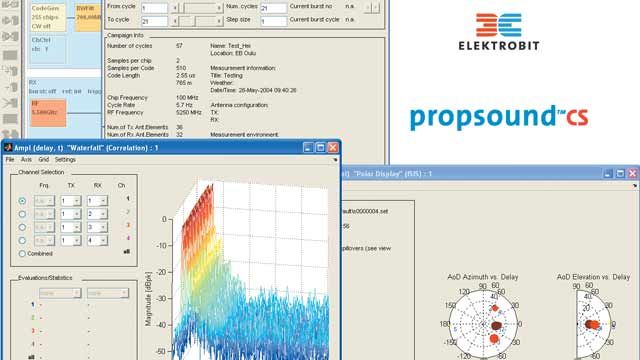Elektrobit Testing Ltd. Develops High-Resolution Radio Channel Measuring System
"MathWorks tools saved us approximately one engineer-year to date and enabled us to go to market with Propsound™ CS faster than we could have imagined."
Challenge
Solution
Results
- Development time-to-market reduced by a year
- Measurement data visualized in real time
- Customer needs met

Wireless phone users have all experienced patchy reception. Radio reception disturbances are caused by the radio waves reflecting from different objects in the environment, such as buildings, creating multipath fading. In the past, radio channel sounders could record only narrowband fading characteristics. They were limited in the number of channels and the maximum transmissible data rates--vital parameters particularly in the development of smart antenna and multiple-input/multiple-output (MIMO) systems.
Elektrobit Testing Ltd. used MathWorks tools to develop the Propsound™CS, a high-resolution multidimensional radio channel measurement system that detects and analyzes the propagation of radio waves in both time and space. Propsound™CS includes a MATLAB application that enables end users to compute and display all relevant radio channel parameters in real time. The gathered radio channel information can be used for propagation analysis, channel modeling for system simulations, and Propsim radio channel emulators, which enable end users to test the target application in a laboratory against known, realistic, and fully repetitive radio channel conditions.
"Using MATLAB and Simulink as an integral part of the channel sounder, we have extended our technological lead," says Jukka-Pekka Nuutinen, research manager at Elektrobit Testing Ltd. "We could not have done that without these tools."
Challenge
Elektrobit Testing Ltd. set a goal in the year 2000 to create a radio channel sounder that could quickly detect and analyze radio channel properties and propagation paths in real time.
The radio channel sounder transceiver design required complex hardware to precisely capture the received data. A challenging timing structure was adopted to record the wideband spatial and temporal characteristics of the radio channel with the required accuracy.
The sounder equipment would include software to control the system and visualize the data in real time. To enable end users to use the processed data and analyze results of their own simulations, the postprocessing software had to provide extended mathematical operations without extensive programming. Finally, the analysis tool would need to be flexible and expandable so that users could implement new analytical methods and functions.
Solution
Elektrobit Testing Ltd. chose MathWorks tools to model the entire channel sounder system. MATLAB was included as the analysis engine in the commercial version of Elektrobit’s Propsound™CS channel sounder to enable end users to customize and add their own analysis routines, greatly increasing Propsound™CS’s versatility when working with different types of applications and technologies.
Engineers first used Simulink® and DSP System Toolbox™ to model the sounder. During the product integration phase, the performance was verified by running simulations of the Simulink model and comparing results measured with a prototype sounder.
Visualization tools in MATLAB and Signal Processing Toolbox™ helped them to develop a postprocessing solution to analyze and determine the radio channel characteristics, such as the propagation time, angular directions of departure and arrival of the transmitted signal, as well as cross-polarization matrices. The same functionality is also available in the real-time operation mode for immediate data visualization. This is a unique feature of Propsound™CS that enables end users to track online whether the measured data is relevant.
"MATLAB has proven to be a very user-friendly tool when handling large volumes of data," says Nuutinen. "It is a central part of the channel sounder and allows the users to easily extend the analysis algorithms."
The Propsound™CS channel sounder has proven its flexibility with measurements and channel modeling work with wireless standards such as WiMAX and DVB-H.
The postprocessing software has been launched as an independent software tool operating on top of MATLAB, which will be used with channel simulation and measurement data from other sources. The Propsound™CS postprocessing software enables end users to use its processing algorithms for channel modeling and analysis via the MATLAB toolbox user interface. Any intermediate data and results can now be directly imported in and exported out to the MATLAB workspace.
Results
Development time-to-market reduced by a year. "MathWorks tools saved us approximately one engineer year and enabled us to go to market with Propsound™CS faster than we could have imagined," says Nuutinen.
Measurement data visualized in real time. With MathWorks tools, Elektrobit Testing Ltd. attained their project goal of visualizing measurement data in real-time operation, guaranteeing that measurement campaigns were efficient.
Customer needs met. By choosing MATLAB as the computational engine, Elektrobit Testing Ltd. avoided developing their system in C++ and provided their customers with templates for data visualization and analysis capabilities as well as the freedom to modify and implement their own analysis routines.